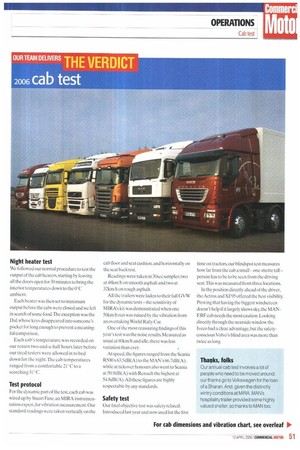Night heater test
Page 51

If you've noticed an error in this article please click here to report it so we can fix it.
we followed our normal procedure to test the output of the cab heaters, starting by leaving all the doors open for 30 minutes to bring the interior temperatures down to the O'C ambient.
Each heater was then set to maximum output before the cabs were closed and we left in search of some food.The exception was the Daf, whose keys disappeared into someone's pocket for long enough to prevent a meaningful comparison.
Each cab's temperature was recorded on our return two-and-a-half hours later before our tired testers were allowed in to bed down for the night.The cab temperatures ranged from a comfortable 21=C to a scorching 31C.
Test protocol
For the dynamic part of the test, each cab was wired up by Stuart Fane. an MIRA instrumentation expert, for vibration measurement. Our standard readings were taken vertically on the cab floor and seat cushion, and horizontally on the seat backrest.
Readings were taken in 30sec samples; two at 48km/h on smooth asphalt and two at 32km/h on rough asphalt.
All the trailers were laden to their full GVW for the dynamic tests — the sensitivity of MIRNs kit was demonstrated when one 50km/h run was ruined by the vibration from an overtaking World Rally Car.
One of the most reassuring findings of this year's test was the noise results. Measured as usual at 80km/h and idle, there was less variation than ever.
At speed, the figures ranged from the Scania R500's 63.5dB(A) to the MAN's 66.7dB(A). while at tickover honours also went to Scania at 50.9dB(A) with Renault the highest at 54.8dB( A).All these figures are highly respectable by any standards.
Safety test
Our final objective test was safety related. Introduced last year and now used for the first time on tractors, our blindspot test measures how far from the cab a small — one-metre tall— person has to be to be seen from the driving seat.This was measured from three locations.
In the position directly ahead of the driver, the Actros and XF95 offered the best visibility. Proving that having the biggest windscreen doesn't help if it largely shows sky, the MANERF cab needs the most caution. Looking directly through the nearside window the Iveco had a clear advantage, but the safetyconscious Volvo's blind area was more than twice as long.
































































































































































































